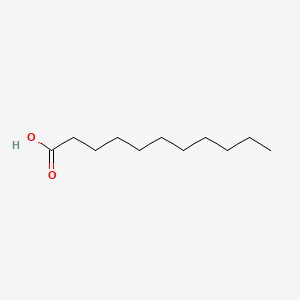| MeSH term | MeSH ID | Detail |
|---|---|---|
| Hemolysis | D006461 | 131 associated lipids |
| Alopecia | D000505 | 14 associated lipids |
UNDECANOIC ACID
UNDECANOIC ACID is a lipid of Fatty Acyls (FA) class. The involved functions are known as Anabolism, Mitosis, Transcriptional Activation, Mismatch Repair and Transcription, Genetic. Undecanoic acid often locates in Protoplasm and spindle microtubule. The associated genes with UNDECANOIC ACID are TERT gene. The related lipids are Fatty Acids and undecanoic acid.
Cross Reference
Introduction
To understand associated biological information of UNDECANOIC ACID, we collected biological information of abnormalities, associated pathways, cellular/molecular locations, biological functions, related genes/proteins, lipids and common seen animal/experimental models with organized paragraphs from literatures.
What diseases are associated with UNDECANOIC ACID?
There are no associated biomedical information in the current reference collection.
Possible diseases from mapped MeSH terms on references
We collected disease MeSH terms mapped to the references associated with UNDECANOIC ACID
PubChem Associated disorders and diseases
What pathways are associated with UNDECANOIC ACID
There are no associated biomedical information in the current reference collection.
PubChem Biomolecular Interactions and Pathways
Link to PubChem Biomolecular Interactions and PathwaysWhat cellular locations are associated with UNDECANOIC ACID?
Visualization in cellular structure
Associated locations are in red color. Not associated locations are in black.
Related references are published most in these journals:
| Location | Cross reference | Weighted score | Related literatures |
|---|
What functions are associated with UNDECANOIC ACID?
Related references are published most in these journals:
| Function | Cross reference | Weighted score | Related literatures |
|---|
What lipids are associated with UNDECANOIC ACID?
Related references are published most in these journals:
| Lipid concept | Cross reference | Weighted score | Related literatures |
|---|
What genes are associated with UNDECANOIC ACID?
Related references are published most in these journals:
| Gene | Cross reference | Weighted score | Related literatures |
|---|
What common seen animal models are associated with UNDECANOIC ACID?
There are no associated biomedical information in the current reference collection.
NCBI Entrez Crosslinks
All references with UNDECANOIC ACID
Download all related citations| Authors | Title | Published | Journal | PubMed Link |
|---|---|---|---|---|
| Avrahami D and Shai Y | Conjugation of a magainin analogue with lipophilic acids controls hydrophobicity, solution assembly, and cell selectivity. | 2002 | Biochemistry | pmid:11841217 |
| Avrahami D and Shai Y | Bestowing antifungal and antibacterial activities by lipophilic acid conjugation to D,L-amino acid-containing antimicrobial peptides: a plausible mode of action. | 2003 | Biochemistry | pmid:14674771 |
| Tang Y et al. | Structural and functional studies on SCO1815: a beta-ketoacyl-acyl carrier protein reductase from Streptomyces coelicolor A3(2). | 2006 | Biochemistry | pmid:17115703 |
| McDonough V et al. | Mutations in erg4 affect the sensitivity of Saccharomyces cerevisiae to medium-chain fatty acids. | 2002 | Biochim. Biophys. Acta | pmid:12020638 |
| Alvarez SD et al. | The compatibility of hepatocytes with chemically modified porous silicon with reference to in vitro biosensors. | 2009 | Biomaterials | pmid:18845334 |
| Pozo OJ et al. | Quantification of testosterone undecanoate in human hair by liquid chromatography-tandem mass spectrometry. | 2009 | Biomed. Chromatogr. | pmid:19353724 |
| Minehara H et al. | Arsonic acid-presenting superparamagnetic iron oxide for pH-responsive aggregation under slightly acidic conditions. | 2011 | Bioorg. Med. Chem. | pmid:21393003 |
| Jain A et al. | Ga labeled fatty acids for cardiac metabolic imaging: Influence of different bifunctional chelators. | 2016 | Bioorg. Med. Chem. Lett. | pmid:27793567 |
| Guo H et al. | Influences of hydrocarbon linkers on the receptor binding affinities of gonadotropin-releasing hormone peptides. | 2013 | Bioorg. Med. Chem. Lett. | pmid:24018188 |
| Escudero E and Subirana JA | Structure of a cyclic dimer of amino undecanoic acid as a model of folding and hydration in polyamides, polypeptides, and related substances. | 2000 | Biopolymers | pmid:10935976 |
